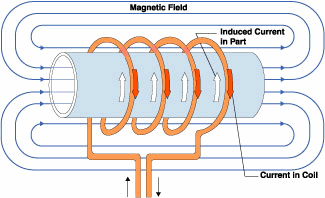20mm ID Dual-Layer Insulated Horizontal Induction Coil
SKU# IHHC.20.5
SKU # :
IHHC.20.5
Dual-layer induction coil for our IH series induction heaters that allows you to feed your work pieces vertically. This coil is specially designed to heat copper and aluminum parts that are non-magnetic. Coil is wrapped with insulation tape to prevent sparks caused by work pieces touching the copper tube.
Specification
| Coil inner diameter (ID) | 20 mm |
| Coil length (away from machine) | 240 mm |
| Copper tube diameter (OD) | 5 mm |
| Coil style | Dual-layer, single-tube, 4 turns (2 inner and 2 outter) |
| Feed direction | Horizonta |


INDUCTION COIL DESIGN It is within the induction coil that the varying magnetic field required for induction heating is developed through the flow of alternating current. So coil design is one of the most important aspects of the overall system. A well-designed coil provides the proper heating pattern for your part and maximizes the efficiency of the induction heating power supply, while still allowing easy insertion and removal of the part.
Induction coils are normally made of copper tubing - an extremely good conductor of heat and electricity - with a diameter of 1/8" to 3/16"; larger copper coil assemblies are made for applications such as strip metal heating and pipe heating. Induction coils are usually cooled by circulating water, and are most often custom-made to fit the shape and size of the part to be heated. So coils can have single or multiple turns; have a helical, round or square shape; or be designed as internal (part inside coil) or external (part adjacent to coil). There is a proportional relationship between the amount of current flow and distance between the coil and part. Placing the part close to the coil increases the flow of current and the amount of heat induced in the part. This relationship is referred to as the coupling efficiency of the coil.
